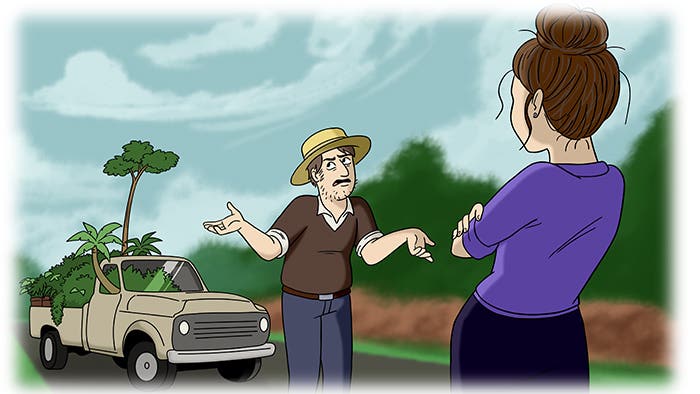Gardening Safety Tips for the Summer Months
Here’s how to protect yourself from dangerous summer weather.
As the weather gets warmer, we look forward to going outside and tending our plants and flowers. But the warm weather also brings some dangers. Thunderstorms at least herald their coming with rumbles of thunder, but there are other risks that are less obvious and occur when the weather appears fine. Summer heat can take a toll on your body and even the sunlight itself can be a hazard.
Stay Safe in the Sun
Sunny days are great for getting out and working in the garden, but sunlight contains potentially harmful ultraviolet rays (officially UVA and UVB). These can cause sunburn, a redness or even blistering of the skin. UV rays can also harm your eyes. Long-term exposure can cause our skin to age and wrinkle prematurely. Most importantly, your risk of skin cancer increases.
Sunlight and UV rays are strongest when the sun is highest in the sky, around noon. (You can get UV rays even on days with a light cloud cover.) For the year, the summer solstice has peak sun intensity. The UV risk also varies with latitude. The sun is higher in the sky and stronger the farther south you go. Hawaii would be the maximum, with south Florida a close second.
To warn of the risk of UV rays on any particular day, the National Weather Service (NWS) issues a UV Index forecast. The index ranges from 0 to 16. Values of 6 or more bring a high risk of some skin or eye damage. Values of 11 or greater are for extreme risk situations. UV Index forecasts are available from the NWS and are often included in the weather forecast by the media.
What do you need to do to protect yourself from potentially harmful UV rays? Avoid sunlight when it’s the most intense (the hours around noon). Stay in the shade or inside. Good advice but not always practical. Sunscreen has been an alternative for years. Use one with an SPF of 30 or higher. But sunscreen can wear off or wash off, even from sweating. And many of us just don’t like putting chemicals on our skin.
What has emerged as a viable option is sun-protective clothing. Start with a wide brim hat and move down to a short- or long-sleeve shirt with UPF ratings of 30 or greater and protective shorts or long pants. And don’t forget your feet, which can easily get burned. Polarized sunglasses are excellent for eye protection.
Stay Safe in the Heat
Another health concern in the summer is the heat itself. Every year in the United States, hundreds of people die from the heat and thousands more become ill, some requiring hospitalization. The elderly and people with chronic illnesses are the most susceptible but even strong, young athletes can succumb.
You’ve probably heard the phrase “It isn’t the heat; it’s the humidity.” Actually, it’s both. Your body cools itself by sweating and having the water evaporate off your skin. That evaporation process produces the cooling, and it is affected by the humidity. Dry air allows more and faster evaporation. Moist air slows and lessens evaporative cooling.
To make it easier to judge the risk of heat-related health problems, meteorologists developed the Heat Index, which combines the effects of heat and humidity. The given value is a “feels-like temperature.” For example, if the temperature is 90 degrees (F) and the relative humidity is 60 percent, the Heat Index would be 100. This means you would feel the same outside if the air was dry and the actual temperature was 100 degrees. A Heat Index of 105 or over puts us in the danger zone.
Keep in mind, the official temperature you’ll hear reported is taken in the shade. In the full sun, you can add 10 to 15 degrees to the reported Heat Index.
How can you avoid heat-related issues? First, avoid strenuous activities during the hottest part of the day—typically noon to about four o’clock p.m. Seek shade if you’re outside. Light-colored clothing is best; it reflects some of the sunlight. Take frequent breaks. Drink plenty of fluids (non-caffeine). Don’t forget those electrolytes, too.
Stay Safe in Thunderstorms
Heat and sun are more innocuous threats. Lightning isn’t. In 2016, it killed 38 people in the United States. Although hard numbers aren’t readily available, it is assumed that each year hundreds of people are struck but not killed by lightning. However, some of these victims have been left with permanent disabilities.
Florida gets the most storms, with the southwestern part of the state averaging over 100 a year. But all 50 states have thunderstorms. They are more frequent in the summer but the southern states can have storms even in the winter. Thunderstorms are most common in the late afternoon, but they can occur at any time of the day.
How do you keep yourself safe from lightning? First, check that weather forecast. It will tell you if storms are possible. Unfortunately, it is impossible to know exactly when and where a storm will develop in the future. But once a storm forms, it will be detected by weather radar. So check the latest radar display. That’s easy today with computers, iPads, smart phones and the like. There are numerous apps that have weather radar.
On the display, look for areas of yellow and especially red. Most likely, that’s where you’ll find a thunderstorm. You can see how far away storms are and determine if they are moving towards you. Thunder, of course, typically warns of the approach of a thunderstorm. It’s true that if you see lightning and start counting until you hear the thunder, the storm is a mile away for every 5 seconds that pass.
So what should do if you’re outside and a thunderstorm is approaching? Get inside. You’re safe in your house or any substantial building (not a shed). Or get in a car. (Open cab vehicles such as tractors do not provide protection from lightning.)
The NWS suggests the “30-30 Rule”. If you start counting when you see lightning and hear the thunder in less than 30 seconds, go inside. Then wait 30 minutes after the last thunder you hear before you go back out.
If you can’t get inside, certainly stay away from trees. Lightning often (but not always) seeks the tallest object. It’s not safe to be even just close to a tree, because lightning can travel down it and into the ground where you’re standing. Getting into a crouch lessens your height and is safer than fully laying on the ground.
Dr. Ed Brotak is a retired meteorologist in North Carolina who often contributes weather- and environment-related stories to Horticulture.







